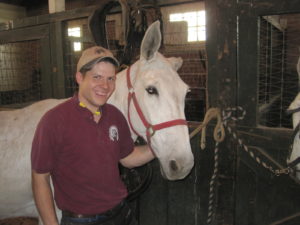George Washington the Horseman

Among his many other great talents, Washington was a skilled blacksmith and horseman. (The American Cincinnatus by Jean Leon Gerome Ferris; 1863-1930)
Happy Independence Day! This is a wonderful time of year to reflect on the great heritage of our country and our craft. We are indebted to our forefathers, who dedicated their lives to independence and freedom. George Washington was the commanding general during the revolutionary war. He was greatly loved by the men he led in battle. He would later become the first president of the United States. George Washington is known for many great character traits. Among them, he was a blacksmith and “the best horseman of his age.”
In her excellent article, George Washington: The All American Equestrian, Rebekah L. Holt says, “From sea to shining sea, the name of George Washington rings with American patriotism. He helped form our nation by his actions, resolution, grit and reliance on Godly Principles. Whether he was the finest public servant in the history of America or “the best horseman of his age,” George Washington’s contributions to the lasting success of the American equine industry are noteworthy for any generation. (equest4truth.com)
Thomas Jefferson described George Washington in a letter to Dr. Walter Jones, “His person, you know, was fine, his stature exactly what one would wish, his deportment easy, erect and noble; the best horseman of his age, and the most graceful figure that could be seen on horseback…” (founders.archives.gov/documents/Jefferson/03-07-02-0052).
Marquis de Chastellux described Washington’s horsemanship skills in this way, “He was so attentive as to give me the horse he rode on the day of my arrival, which I had greatly commended. I found him as good as he is handsome, but above all, perfectly well broke and well trained having a good mouth, easy in hand, and stopping short in a gallop without bearing the bit. I mention these minute particulars, because it is the General himself who breaks all his own horses, and his is a very excellent and bold horseman, leaping the highest fences, and going extremely quick, without standing upon his stirrups, bearing on the bridle, or letting his horse run wild. (Shiner, C.A., The War for Independence, pg. 20)
Along with George Washington’s oft praised horsemanship skills, he was also an accomplished blacksmith. His blacksmith shop at Mount Vernon still stands today. In those days, the blacksmith (known for all around forge work) usually shod the horses as well. With Washington’s horsemanship skills and blacksmithing skills combined, it stands to reason that he would shoe his horses as well.
George Washington is also known for importing and popularizing mules and specifically mammoth jacks to do farm work. He began producing them as early as 1786 (Butler, Principles of Horseshoeing (P3), pg. 919).
In 1786, the Marquis de Lafayette sent Washington a black Maltese jack called “Knight of Malta”, along with several jennies. These animals bred with the Andalusians, and the crossing of the Spanish and Maltese strains created highly valuable stock known as the “compound” – – the beginning of the “American Mammoth Jackstock”.
After the Revolutionary War, Washington started a program to develop a larger, stronger mule to be used on farms – – to replace horses in the field. In less than fifteen years Washington had 58 mules working at Mount Vernon. In 1786, Washington advertised the “compound’s” services in a Philadelphia journal. The stud fee for serving horses was a third less than it was for serving donkeys. It is said that mules from Washington’s stock became the forerunners of mules that were the backbone of American agriculture for generations in the southern U.S. (mulemuseum.org).
George Washington’s favorite horses were a chestnut named Nelson and a half-arabian dapple grey horse named Blueskin. The famous painting of Washington praying at Valley Forge seems to depict him with his horse, Blueskin. In later years, the horses retired at Mount Vernon where they were “[kept] in a nice stable and [fed] away at their ease for their past services.” (ushistory.org/valleyforge/youasked/024.htm)
George Washington was a great horseman and serves as a great reminder of how we should strive to be better horsemen in our craft. The farrier craft has an incredible heritage. It is an honor to work in a craft that many great men and women before us have pioneered. As we celebrate the Fourth of July, we remember our fore-bearers and express our gratitude for their examples and sacrifices.
Related Posts
-
by Doug Butler PhD, CJF, FWCF Butler Professional Farrier S...Nov 15, 2013 / 0 comments
-
Many problems with horses are caused by horse-loving people....Mar 14, 2019 / 0 comments
-
By Doug Butler PhD, CJF, FWCF Danny ward passed away a few d...Mar 29, 2018 / 0 comments
Blog Categories
- Anatomy
- Best Business Practices
- Conformation
- Current Events
- Customer Service
- Draft Horse Shoeing
- Equine Soundness
- Essential Anatomy Kit
- Farrier Careers
- Farrier training
- Foal soundness
- Horse Care
- Horse Foot Care
- Horse Owner Tips
- Horsemanship
- Horseshoeing
- Horseshoeing History
- Iron and Forge Work
- Student Spotlight
- Uncategorized
- Veterinary Care
Blog Archives
Contact Us
Butler Professional Horseshoeing School
495 Table Road
Crawford, NE 69339
(800) 728-3826
jacob@dougbutler.com
Subscribe to Our Blog
Get Our Free e-Book!
If you think you want to become a farrier (or know someone who does), this book can help you make that decision. Horse owners will learn the importance of choosing a qualified farrier and how to select the “right” one.
[ Get the e-Book Now! ]
- Follow:


